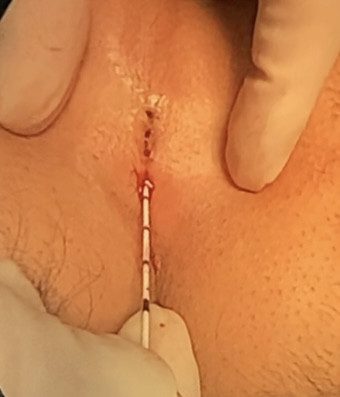Pilonidal Sinus/Cyst surgeries aim to clean and remove or obliterate the infected sac or tract from under the skin in the tail bone area.
The traditional cutting out the diseased area and suturing the skin is burdened by an unacceptably high recurrence rate. The cut is in the midline of the body, where tissue forces are pulling from both sides, so the wound, most often in the deeper level, tends to jump open and presents as an abscess or dehiscence.
If the wound is not sutured but rather treated open, it heals up, but it takes many weeks or even months.
For recurrent pilonidal sinus there are different kind of flap operations which rotate healthy skin to the area to achieve good primary healing. These work well, however they changes the aesthetics of the area and they come with a few weeks after surgery, when extra caution needs to be exercised to avoid pressure on the area.
EPSIT, SiLac
Endoscopic Pilonidal Sinus Treatment is a new way of treating pilonidal disease, by examining and cleaning out the cyst and sinuses through a 5 mm in diameter endoscope and closing it with fibrin glue filling.
SiLac (Sinus Laser Assisted Closure) is another minimally invasive approach to pilonidal disease, when the pilonidal abscess or cyst cavity and additional tracts are cleared of debris and simply destroyed and sealed with laser energy delivered via a less than 2 mm in diameter laser probe.
These minimally invasive procedures are much less painful and come with a much shorter downtime. It still takes time to heal fully and there is a 10-15% recurrence rate, therefore a thorough follow-up is necessary.
What to expect when going for this procedure?
EPSIT is done under general anaesthesia (or at least deep sedation), SiLac can be done even with local anesthesia and a moderate sedation only, but of course if you prefer to sleep it can be arranged.
There is no need for any bowel preparation before pilonidal sinus surgery, but 6 hours of fasting is required because of the sedation.
After the surgery you will feel minimal pain, because your doctor will give you a numbing injection in the area of the disease. Once the effect of this goes away, the pain will be minimal and will be easily suppressed with simple oral painkillers, which you will be advised to take for a few days only.
Your doctor will let you go home a few hours after the procedure, once you are fully awake, pain free and managed to eat/drink.
Your doctor will give you a number to contact her in case of emergency as well as arrange a free follow-up visit for you within 2 to 5 days.
